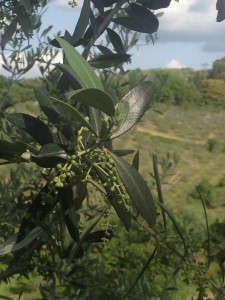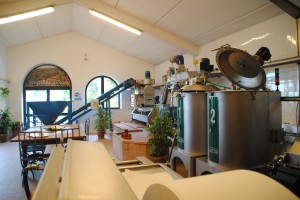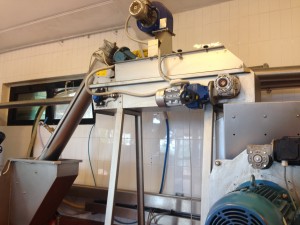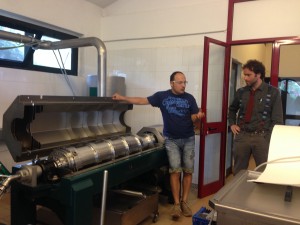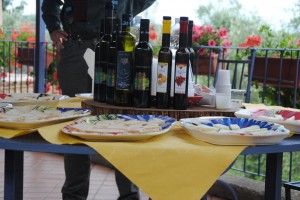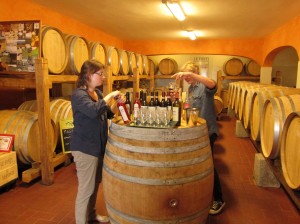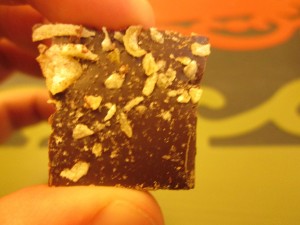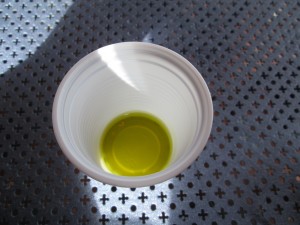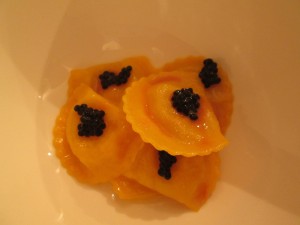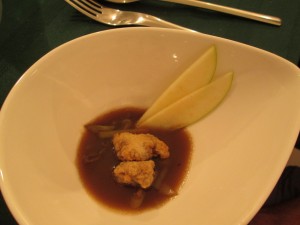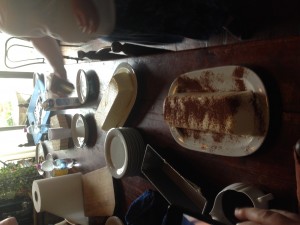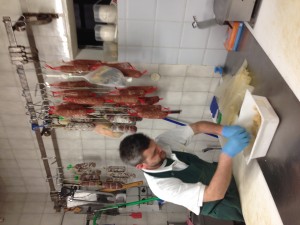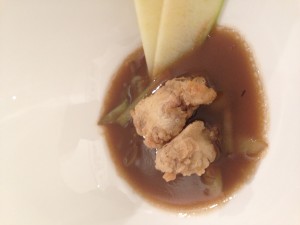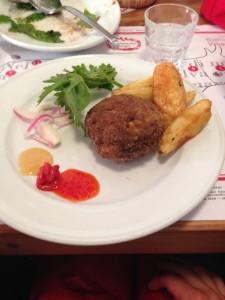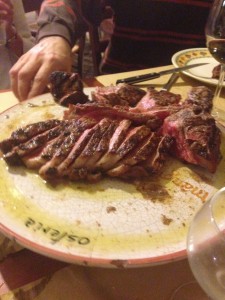Cristiano Tomei and the Tuscan Tradition – Bethanne Bartscherer
June 11th, 2014 by bbarts15Cristiano Tomei is often described as crazy, uninhibited, and fearless. He has been likened to musical artists such as Jimi Hendrix and Frank Zappa, and nearly every restaurant critic makes a point of his iconic beard and long hair. In fact, Tomei’s eccentric personality is only matched by the meals he prepares. As one critic explains, “his kitchen is his playground… his food is a gastronomic ‘trip;’ you’re not exactly sure where you’ve been, but you want to go back” (Sofie Delauw, The Curious Eater). Tomei is well known for stacking simple, traditional courses upon extreme, inventive dishes that preserve the element of surprise in L’Imbuto, his restaurant. Each of Tomei’s dishes captures the taster’s full attention, and predicting the next course is nearly impossible. L’Imbuto’s location in the Lucca Center of Contemporary Art (Lu.CCA) enhances the dining experience further; the parallels between Tomei’s courses and the artwork are apparent, and Tomei’s dishes become an exhibit on their own. In this way, Cristiano Tomei is an artist, and his artwork evokes emotion in his consumers. Furthermore, when Tomei’s courses are presented together in his eleven course meal, and the food is experienced in its entirety, the chef’s larger, overarching concept is understood. Despite Tomei’s extreme style and eccentric persona, his inventive dishes all stem from his Tuscan roots. His concept, therefore, is an adaptation and innovation of tradition.
A Chef From Versilia
Cristiano Tomei was born and raised in Viareggio, a coastal city in northern Tuscany, where seafood plays an integral role in local cuisine. This upbringing influenced Tomei’s own cooking style. During the eleven-course meal that we experienced at L’Imbuto, seafood was a dominating theme. The Tuscan culinary tradition calls for a simplicity of ingredients, and Tomei followed this belief by utilizing only a handful of spices to create complex flavors. Additionally, Tomei’s innovation and adaptation of traditional Tuscan dishes reflects his loyalty to his homeland’s culinary history. The Tuscan love and respect for food is most notable in the practice of using all parts of the animals and vegetables in food preparation. Tomei adhered to this principle in his use of conventionally overlooked ingredients and animal organs.
Tomei’s general approach and attitude towards food is similar to that of many Tuscan chefs. In a recent interview, when asked where his favorite place to shop for food is, Tomei explained that he enjoys walking into the woods to “try the herbs and experience what nature has to offer.” Additionally, he referenced a local farmer’s market in Lucca, the Forum Boarium, where he purchases high quality, locally grown food (Maddalena Fossati, Vanity Food). In this way, he echoes the larger Tuscan traditions of designing recipes and menus based on the locality and seasonality of ingredients. When asked to name a chef whom he respects, Tomei named René Redzepi, head chef at Noma (largely regarded as the world’s best restaurant) in Copenhagen (Fine Dining Lovers). Noma emphasizes the development of the Nordic cuisine and environmental sustainability for each of its recipes. In order to achieve this, the restaurant incorporates exclusively local ingredients that are selected according to the season. Perhaps Tomei admirers Redzepi for this aspect of Noma, and strives to similiarly use locally grown ingredients to highlight the Tuscan tradition. Overall, Tomei’s use of simple, few ingredients to create inventive, extreme dishes reflects innovation from his roots.
The Meal at L’Imbuto
Updated Cecina
During my own experience dining at L’Imbuto, one course in particular epitomized Tomei’s theme of creatively expanding upon tradition. Tomei prepared a sea urchin cecina, topped with shrimp. Cecina is a traditional street food in Tuscany, and is made using chickpea flour, salt, and water. The mixture is baked in a wood burning oven in a thin pan until crispy and golden brown, and is enjoyed fresh out of the oven. Traditionally, cecina is an inexpensive snack. Personally, I purchased cecina at a hole-in-the-wall in Pisa, and ate it as I strolled the evening streets. At L’Imbuto, however, the cecina was artfully presented as an elegant seafood dish. The sea urchin surprisngly enhanced the chickpea flavors of the cecina. In fact, it both innovated the traditional streetfood and adapted the dish to fit the seafood concept of the overall meal. On L’Imbuto’s website, Tomei is stated to be raised “between the hills and the sea” in Tuscany. This dish, therefore, embodies an appreciation for both aspects of Tomei’s upbringing. The sea urchin and shrimp pay homage to Viareggio, while the cecina base recalls the city of Lucca where L’Imbuto is located. The simplicity of the dish is also extremely Tuscan; by using very few, simple ingredients, Tomei achieves a creative, full-bodied course. Overall, this dish expresses Tomei’s own creativity and loyalty to his roots.
A Wild Risotto
In another course, Tomei prepared a hearty risotto with zafferano and topped with edible wildflowers and herbs. Zafferano risotto is traditionally Tuscan, from the city of Florence. This course was perhaps the least extreme, and offered a comforting break from more adventurous and unusual dishes. Most notable, however, was the risotto’s garnish of wildflowers. This refers back to Tomei’s ideal food store: the forest. Evidently, his use of unconventional herbs and flowers suggest that Tomei might actually have picked them while walking in the woods, rather than purchased them in a store. In this way, the risotto exemplifies authenticity and heritage. The flowers not only made the dish look beautiful, but also brought forth the hearty flavors of the risotto and evoked tastes of genuine tradition. In fact, flanked by exotic courses, this dish tasted more like Tomei borrowed my grandmother’s favorite recipe and prepared the dish with the Italian love of food. The wildflowers that topped Tomei’s risotto updated the traditional zaffareno meal and added his personal love for experiencing “what nature has to offer” in the forest.
Unconventional Ravioli
Of the eleven courses, two incorporated ravioli. The first was filled with a liquid blend of olive oil and parmigian cheese, and was topped with cuttlefish. This course held true for the seafood theme of the evening by incorporating the cuttlefish. However, it also utilized a traditional concept, ravioli, and unusually created a liquid filling. Perhaps this reflects the influence of Ferran Adrià, head chef at El Bulli in Barcelona, on Tomei. The documentary Cooking in Progress explores the inner workings of Adrià’s laboratory kitchen. One dish that was discussed extensively was a “disappearing ravioli,” in which the thin shell dissolves in water, revealing a liquid center. Tomei may have adapted Adrià’s technique to a more Tuscan ravioli, and instead used traditional pasta and an olive oil center. In this way, Tomei is inflenced by Adrià, who was largely recognized as one of the best chefs in the world. Despite his attempt to adapt Adrià’s technique, Tomei preserves his Tuscan identity by conforming to the Tuscan tradition and his own seafood concept. This course reveals simple ingredients (olive oil, parmigian, a simple pasta shell, and cuttlefish) without any complex flavors, yet the element of surprise derived from the liquid center is present. With minimal ingredients, Tomei achieves an appreciation for Adrià, a loyalty to Tuscan tradition, an incorporation of his seafood theme, and the element of surprise.
In Tomei’s second ravioli, he uses a potato and whiskey filling, and tops each ravioli with black caviar. This dish more closely parallels the Tuscan tradition of potato stuffed ravioli, or gnocci, yet the whiskey taste offers an unusual pairing to evoke a more extreme flavor. The caviar topping, similar to the cuttlefish, incorporates this course into the seafood theme, and adds a third flavor into the dish. In this way, both ravioli courses are constructed similary. Both ravioli shells are stuffed with two ingredients, one liquid and one solid: olive oil and parmigian, or whiskey and potato. The pasta shell is constant between the courses, yet each is topped with a different fish: cuttlefish or caviar. In this way, a parallel is established between the two courses, as a miniature theme within the overall concept. Consumers are forced to compare the two types of ravioli, since one immediately follows the other. While they visually appear very similar, and have similar texture, the surprise is generated from the sharply different tastes in the transition from olive oil to whiskey. Perhaps this is why Tomei presents the olive oil first; it acts as a milder scaffold to establish the structure of the liquid ravioli center and fish topping. This ensures that the diner focuses on the surprising taste of the whiskey and caviar, rather than pay attention to the ravioli itself or the texture of the filling. Furthrmore, unlike in traditional Tuscan ravioli and gnocci, the pasata is not topped with any kind of sauce, as if the ravioli is inside out. The sauce becomes the filling, while the traditional solid filling is left on the outside in the form of the cuttlefish and caviar.
Tomei’s “Special Salad”
The most memorable aspect of Tomei’s eleven course meal was undeniably reserved for the end, just before dessert. Waitresses asked diners to taste and guess the ingredients of the chef’s “special salad,” and after a few wrong guesses (from cartilidge to squirrel) it was revealed that Tomei prepared fried bits of cow brain to accompany the artichoke heart, green apple slices, and anchovy sauce of the dish. Initially, the cow brain evoked a visceral reaction of shock and, in some, disgust. Tomei’s goal of achieving shock and evoking emotion through food was most potently experienced during this course. It may seem as though Tomei’s urge to fry beef brain is derived from his eccentric, extreme personality, where the “kitchen is his playground” and Tomei will fearlessly (and skillfully) incorporate anything into his dishes. To some, it may appear as though the purpose of the cow brain was solely for shock value, and that it fails to connect to his larger themes. On the contrary, upon deeper analysis it is probable that Tomei’s use of cow brain is based on his own Tuscan upbringing. Rather than incorporate fish, Tomei exemplifies the Tuscan tradition of utilizing every part of the animal or vegetable in order to minimize waste. Just as celebrity butcher Dario Cecchini emphasizes his policy of “nose to tail,” Tomei elegantly prepares an unconventional part of the cow to highlight the importance of not wasting food. Andrea Falaschi, the butcher who supplies L’Imbuto with high quality meat, also abides by this philosophy. Tomei attempts to convince consumers that, if prepared well, even the most seemingly undesirable parts of the animal can be served as high quality cuisine. In this way, the brain represents far more than simply a shocking display of Tomei’s fearlessness, and echoes the Tuscan loyalty to using all ingredients available.
Conclusion
Cristiano Tomei’s technique and style embody his own adaptation of his Tuscan roots. By understanding his methods, it is possible to not only appreciate his extreme and creative dishes, but also to recognize the concepts that he uses to establish a consistent theme throughout the eleven courses. Furthermore, Tomei’s upbringing “between the hills and the sea” is unmistakenly evoked in several of his dishes which proves that no amount of creativity and eccentricity can completely overshadow one’s culinary roots. Consumers can trace patterns between Tomei and colleagues such as René Redzepi, Ferran Adrià, Dario Cecchini, and Andrea Falaschi, and through these threads of connections understand how Tomei is influenced by modern giants of the culinary world. As a whole, Tomei’s work reflects larger themes of his own innovative style, modern influencers, and an undeniable loyalty to his homeland.
Works Cited
“Cristiano Tomei.” Fine Dining Lovers. S. Pellegrino, Web. <http://www.finedininglovers.it/people/c0116c7d-d843-4cdd-a140-d060c6088a65/cristiano-tomei/>.
Delauw, Sofie. “Lucca: The Beautiful Mind of Cristiano Tomei.” The Curious Eater. 28 Mar. 2012. Web. <Lucca: The Beautiful Mind of Cristiano Tomei>.
Fossati, Maddalena. “Intervista Allo Chef Cristiano Tomei.” Vanity Food. Vanity Fair, Web. <http://www.vanityfair.it/vanityfood/foodstar/13/07/24/chef-cristiano-tomei-ricetta>.
L’Imbuto Ristorante. Web. <http://www.limbuto.it/>.







